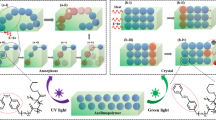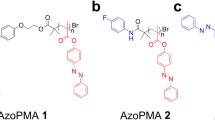Abstract
Phase-change azobenzene derivatives can store and release heat upon isomerization. The amount and rate of heat output are affected by the azobenzene crystallization and isomerization, which are in turn governed by molecular structure and interactions. Thus, optimizing molecular structure is a promising method to control heat release at different temperatures. Herein, we prepared three asymmetric alkoxy-substituted azobenzene molecules (s-Azo) with similar molecular weights but different substituents to investigate the trade-off between crystallization and isomerization. Temperature-dependent crystallizability and photo-induced iso-merization kinetics of all s-Azo were studied. Results indicate that n-alkoxy substitution endows s-Azo with high crystallization enthalpy (ΔHCE) due to strong van der Waals forces, but steric hindrance lowers the degree of isomerization. Short branched alkyl substitution reduces intermolecular interactions and favors the isomerization, which leads to an increase in isomerization enthalpy (ΔHIE) but decreases ΔHCE. The n-alkoxy-substituted s-Azo exhibits photoinduced high-energy heat release with an enthalpy of up to 343.3 J g−1 and a power density of 413 W kg−1 at a wide temperature range from −60.49 to 34.76°C. The synchronous heat release in a distributed energy utilization annular device achieves a temperature rise of 6.3°C at a low temperature environment (−5°C). Results demonstrate that phase-change azobenzene derivatives can be designed and developed for ideal energy-storage systems by optimizing molecular structures and interactions.

摘要
相变偶氮苯衍生物可以基于异构化储存和释放热量. 热量输出量和速率受偶氮苯结晶和异构化的影响, 同时也受分子结构和相互作用的制约. 因此, 优化分子结构是控制不同温度下热量释放的一种有效方式. 在此, 我们制备了三个不对称的烷氧基取代的偶氮苯分子(s-Azo), 其分子量相似但取代基不同, 以研究结晶和异构化之间的权衡. 我们研究了s-Azo的温控结晶性和光诱导的异构化动力学. 结果表明, 由于较强的范德华力, 正烷氧基取代使s-Azo具有较高的结晶焓(ΔHCE), 但立体阻碍降低了异构化程度. 短烷基支化降低了分子相互作用, 有利 于异构化, 使异构化焓(ΔHIE)增加, 但降低了ΔHCE. 正烷氧基取代的s-Azo在−60.49至34.76°C的宽温度范围内表现出光诱导的高能热释放, 焓值高达343.3 J g−1, 功率密度为413 W kg−1. 同步放热使分布式能量利 用的环形装置在低温环境(−5°C)下实现了6.3°C的温升. 结果表明, 相变 偶氮苯衍生物可以通过优化分子结构和相互作用应用于理想的储能 系统.
Similar content being viewed by others
References
Moth-Poulsen K, Ćoso D, Börjesson K, et al. Molecular solar thermal (MOST) energy storage and release system. Energy Environ Sci, 2012, 5: 8534–8537
Wang Z, Erhart P, Li T, et al. Storing energy with molecular photo-isomers. Joule, 2021, 5: 3116–3136
Nielsen MB, Ree N, Mikkelsen KV, et al. Tuning the dihydroazulene-vinylheptafulvene couple for storage of solar energy. Russ Chem Rev, 2020, 89: 573–586
Mansø M, Petersen AU, Wang Z, et al. Molecular solar thermal energy storage in photoswitch oligomers increases energy densities and storage times. Nat Commun, 2018, 9: 1945
Kwaria D, McGehee K, Liu S, et al. Visible-light-photomeltable azo-benzenes as solar thermal fuels. ACS Appl Opt Mater, 2023, 1: 633–639
Abedi M, Pápai M, Mikkelsen KV, et al. Mechanism of photoinduced dihydroazulene ring-opening reaction. J Phys Chem Lett, 2019, 10: 3944–3949
Orrego-Hernández J, Dreos A, Moth-Poulsen K. Engineering of nor-bornadiene/quadricyclane photoswitches for molecular solar thermal energy storage applications. Acc Chem Res, 2020, 53: 1478–1487
Wang ST, Tan P, Weng WQ, et al. Photoresponsive metal-organic polyhedra in metal-organic frameworks: Achieving “real” responsiveness. Sci China Mater, 2023, 66: 2726–2732
Merino E. Synthesis of azobenzenes: The coloured pieces of molecular materials. Chem Soc Rev, 2011, 40: 3835–3853
Wen ZB, Snap RF, Raquez JM, et al. Unique two-way free-standing thermo- and photo-responsive shape memory azobenzene-containing polyurethane liquid crystal network. Sci China Mater, 2020, 63: 2590–2598
Fuentes E, Gerth M, Berrocal JA, et al. An azobenzene-based single-component supramolecular polymer responsive to multiple stimuli in water. J Am Chem Soc, 2020, 142: 10069–10078
Saydjari AK, Weis P, Wu S. Spanning the solar spectrum: Azopolymer solar thermal fuels for simultaneous UV and visible light storage. Adv Energy Mater, 2017, 7: 1601622
Gao J, Feng Y, Fang W, et al. Co-harvest phase-change enthalpy and isomerization energy for high-energy heat output by controlling crystallization of alkyl-grafted azobenzene molecules. Energy Environ Mater, 2023, e12607
Lv JA, Liu Y, Wei J, et al. Photocontrol of fluid slugs in liquid crystal polymer microactuators. Nature, 2016, 537: 179–184
Xu WC, Sun S, Wu S. Photoinduced reversible solid-to-liquid transitions for photoswitchable materials. Angew Chem Int Ed, 2019, 58: 9712–9740
Bandara HMD, Burdette SC. Photoisomerization in different classes of azobenzene. Chem Soc Rev, 2012, 41: 1809–1825
Akiyama H, Yoshida M. Photochemically reversible liquefaction and solidification of single compounds based on a sugar alcohol scaffold with multi azo-arms. Adv Mater, 2012, 24: 2353–2356
Knothe G, Dunn RO. A comprehensive evaluation of the melting points of fatty acids and esters determined by differential scanning calorimetry. J Americ Oil Chem Soc, 2009, 86: 843–856
Xu X, Wang G. Molecular solar thermal systems towards phase change and visible light photon energy storage. Small, 2022, 18: 2107473
Griffiths K, Halcovitch NR, Griffin JM. Crystalline azobenzene composites as photochemical phase-change materials. New J Chem, 2022, 46: 4057–4061
Soulé ER. Thermodynamic model of phase transitions induced by cis-trans thermal- and photo-isomerization of azobenzenes. Chem Phys Lett, 2022, 794: 139503
Zhong HY, Chen L, Ding XM, et al. Physio- and chemo-dual cross-linking toward thermoand photo-response of azobenzene-containing liquid crystalline polyester. Sci China Mater, 2018, 61: 1225–1236
Cho EN, Zhitomirsky D, Han GGD, et al. Molecularly engineered azobenzene derivatives for high energy density solid-state solar thermal fuels. ACS Appl Mater Interfaces, 2017, 9: 8679–8687
Hu Z, Zhang D, Yu L, et al. Light-triggered C60 release from a graphene/cyclodextrin nanoplatform for the protection of cytotoxicity induced by nitric oxide. J Mater Chem B, 2018, 6: 518–526
Sheng S, Zhu Z, Wang Z, et al. Bioinspired solar anti-icing/de-icing surfaces based on phase-change materials. Sci China Mater, 2022, 65: 1369–1376
Kolpak AM, Grossman JC. Azobenzene-functionalized carbon nano-tubes as high-energy density solar thermal fuels. Nano Lett, 2011, 11: 3156–3162
Gerkman MA, Gibson RSL, Calbo J, et al. Arylazopyrazoles for long-term thermal energy storage and optically triggered heat release below 0°C. J Am Chem Soc, 2020, 142: 8688–8695
Norikane Y, Uchida E, Tanaka S, et al. Photoinduced crystal-to-liquid phase transitions of azobenzene derivatives and their application in photolithography processes through a solid-liquid patterning. Org Lett, 2014, 16: 5012–5015
Hu J, Li X, Ni Y, et al. A programmable and biomimetic photo-actuator: A composite of a photo-liquefiable azobenzene derivative and commercial plastic film. J Mater Chem C, 2018, 6: 10815–10821
Han GGD, Li H, Grossman JC. Optically-controlled long-term storage and release of thermal energy in phase-change materials. Nat Commun, 2017, 8: 1446
Ishiba K, Morikawa M, Chikara C, et al. Photoliquefiable ionic crystals: A phase crossover approach for photon energy storage materials with functional multiplicity. Angew Chem Int Ed, 2015, 54: 1532–1536
Liu Y, Wang H, Liu P, et al. Azobenzene-based macrocyclic arenes: Synthesis, crystal structures, and light-controlled molecular encapsulation and release. Angew Chem, 2021, 133: 5830–5834
Qiu Q, Shi Y, Han GGD. Solar energy conversion and storage by photoswitchable organic materials in solution, liquid, solid, and changing phases. J Mater Chem C, 2021, 9: 11444–11463
Yoshida Z. New molecular energy storage systems. J Photo Chem, 1985, 29: 27–40
Martins GF, Cardoso BP, Galamba N, et al. Solar-thermal fuels and the role of carbon nanomaterials: A perspective with emphasis on the azobenzene system. Energy Fuels, 2023, 37: 1731–1756
Shangguan Z, Sun W, Zhang ZY, et al. A rechargeable molecular solar thermal system below 0°C. Chem Sci, 2022, 13: 6950–6958
Weston CE, Richardson RD, Haycock PR, et al. Arylazopyrazoles: Azoheteroarene photoswitches offering quantitative isomerization and long thermal half-lives. J Am Chem Soc, 2014, 136: 11878–11881
Zhang ZY, He Y, Wang Z, et al. Photochemical phase transitions enable coharvesting of photon energy and ambient heat for energetic molecular solar thermal batteries that upgrade thermal energy. J Am Chem Soc, 2020, 142: 12256–12264
Hu J, Huang S, Yu M, et al. Flexible solar thermal fuel devices: Composites of fabric and a photoliquefiable azobenzene derivative. Adv Energy Mater, 2019, 9: 1901363
Luo L, Lyu X, Tang Z, et al. Thin-film self-assembly of block copolymers containing an azobenzene-based liquid crystalline polymer and a poly(ionic liquid). Macromolecules, 2020, 53: 9619–9630
Chi H, Mya KY, Lin T, et al. Thermally stable azobenzene dyes through hybridization with POSS. New J Chem, 2013, 37: 735–742
Jerca FA, Jerca VV, Hoogenboom R. Advances and opportunities in the exciting world of azobenzenes. Nat Rev Chem, 2022, 6: 51–69
Cheng HB, Zhang S, Qi J, et al. Advances in application of azobenzene as a trigger in biomedicine: Molecular design and spontaneous assembly. Adv Mater, 2021, 33: 2007290
Han GD, Park SS, Liu Y, et al. Photon energy storage materials with high energy densities based on diacetylene-azobenzene derivatives. J Mater Chem A, 2016, 4: 16157–16165
Bléger D, Schwarz J, Brouwer AM, et al. o-Fluoroazobenzenes as readily synthesized photoswitches offering nearly quantitative two-way iso-merization with visible light. J Am Chem Soc, 2012, 134: 20597–20600
Dang T, Dong D, Zhang J, et al. Thiazolylazopyrazoles as nonsymmetric bis-heteroaryl azo switches: High-yield visible-light photo-isomerization and increased Z-isomer stability by o-carbonylation. Angew Chem Int Ed, 2023, 62: e202301992
Kant K, Shukla A, Sharma A, et al. Melting and solidification behaviour of phase change materials with cyclic heating and cooling. J Energy Storage, 2018, 15: 274–282
Pielichowska K, Pielichowski K. Phase change materials for thermal energy storage. Prog Mater Sci, 2014, 65: 67–123
Zhang Q, Xia T, Zhang Q, et al. Biomass homogeneity reinforced carbon aerogels derived functional phase-change materials for solar-thermal energy conversion and storage. Energy Environ Mater, 2023, 6: e12264
Hao Y, Huang S, Guo Y, et al. Photoinduced multi-directional deformation of azobenzene molecular crystals. J Mater Chem C, 2019, 7: 503–508
Yao J, Sun L, Xiao Y, et al. Impact of surface free energy on two-dimensional crystallization. Sci China Mater, 2023, 66: 1511–1517
Beharry AA, Woolley GA. Azobenzene photoswitches for biomolecules. Chem Soc Rev, 2011, 40: 4422–4437
Dias AR, Minas Da Piedade ME, Martinho Simöes JA, et al. Enthalpies of formation of cis-azobenzene and trans-azobenzene. J Chem Ther-moDyn, 1992, 24: 439–447
Wang H, Feng Y, Yu H, et al. Utilisation of photo-thermal energy and bond enthalpy based on optically triggered formation and dissociation of coordination bonds. Nano Energy, 2021, 89: 106401
Acknowledgements
This work was financially supported by the National Key R&D Program of China (2022YFB3805702), the State Key Program of National Natural Science Foundation of China (51973152 and 52130303), and the Science Foundation for Distinguished Young Scholars in Tianjin (19JCJQJC61700). The authors would like to thank Dr. Joseph Elliot at the University of Kansas for her assistance with English language and grammatical editing of the manuscript.
Author information
Authors and Affiliations
Contributions
Feng W and Feng Y conceived the project and supervised the research. Yang Q performed the synthesis and characterization of s-Azo. Ge J, Qin M, Wang H, Yang X, Zhou X and Zhang B helped in the analysis of the results. Yang Q wrote the manuscript. All authors discussed the results and revised the manuscript.
Corresponding authors
Ethics declarations
The authors declare that they have no conflict of interest.
Additional information
Supplementary information
Supporting data are available in the online version of the paper.
Qingbin Yang is now pursuing his MS degree under the supervision of Prof. Wei Feng at the School of Materials Science and Engineering, Tianjin University. His research interests include the synthesis, mechanism and applications of photo-responsive azobenzene-based phase change materials.
Yiyu Feng is a professor at the School of Materials Science and Engineering, Tianjin University. He obtained his PhD degree from Tianjin University in 2009 and held an academic position at Tianjin University in 2009. Currently, his research is focused on solar-thermal conversion and thermal interfacial materials and composites, as well as their applications in heat-control systems.
Wei Feng is a professor at the School of Materials Science and Engineering, Tianjin University. He obtained his PhD degree from Xi’an Jiaotong University (China) in 2000. Then, he worked at Osaka University and Tsinghua University as a JSPS fellow and postdoctoral researcher, respectively. In 2004, he became a full professor at Tianjin University. His research interests include photoresponsive organic molecules and their derivatives, thermal conductive and high-strength carbon-based composites, and new fuorinated carbon materials and functional polymers.
Supplementary Information
40843_2023_2477_MOESM1_ESM.pdf
Controllable Heat Release of Phase-Change Azobenzenes by Optimizing Molecular Structures for Low-temperature Energy Utilization
Rights and permissions
About this article
Cite this article
Yang, Q., Ge, J., Qin, M. et al. Controllable heat release of phase-change azobenzenes by optimizing molecular structures for low-temperature energy utilization. Sci. China Mater. 66, 3609–3620 (2023). https://doi.org/10.1007/s40843-023-2477-x
Received:
Accepted:
Published:
Issue Date:
DOI: https://doi.org/10.1007/s40843-023-2477-x




